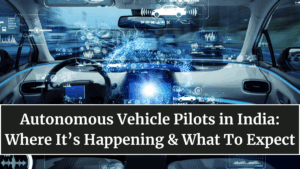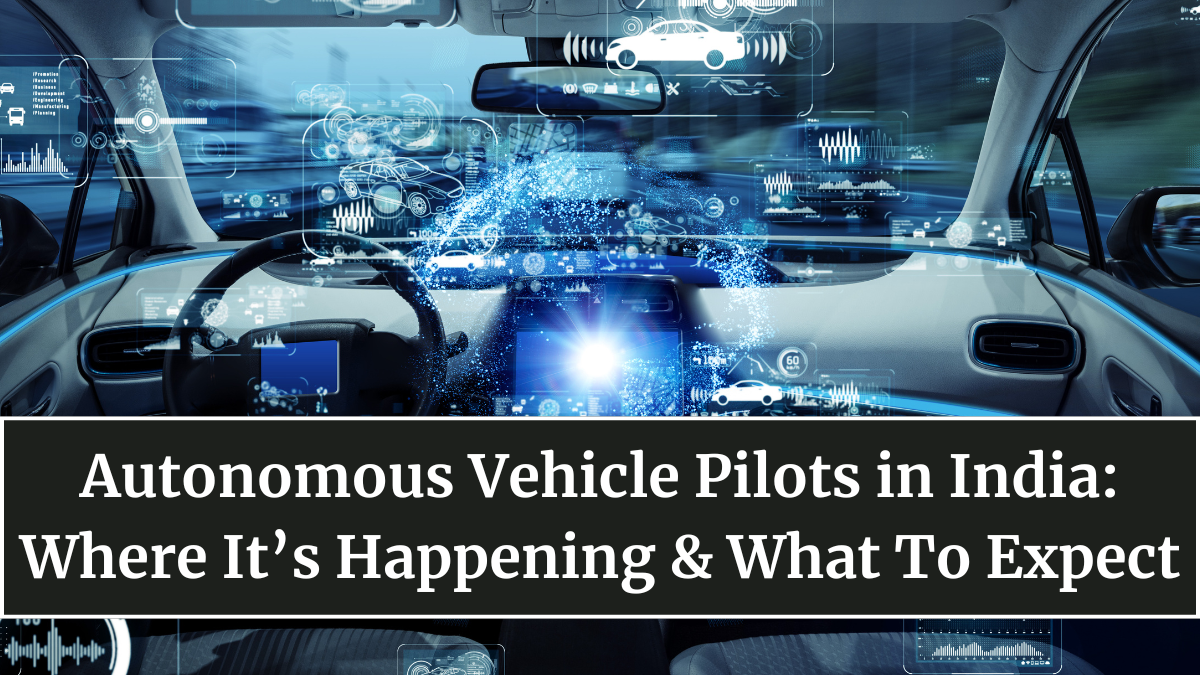India is stepping into the age of self-driving cars — cautiously, but confidently. The autonomous vehicle pilots in India rolling out in 2025 mark a bold new phase for the country’s mobility sector. From bustling city roads to controlled industrial zones, these pilot programs are testing how artificial intelligence, sensors, and real-world data can make transportation smarter, safer, and more efficient. While fully autonomous driving might still be years away, India’s experiments today are paving the way for tomorrow’s automated highways.

The Rise of Self-Driving Experiments in India
The idea of autonomous vehicles in India once sounded futuristic, but with advancements in AI, computer vision, and sensor fusion, it’s becoming a reality. Major cities like Bengaluru, Hyderabad, and Pune have become testing grounds for autonomous shuttles and last-mile delivery bots.
Companies such as Tata Elxsi, Bosch India, and Minus Zero are leading innovation in this field, focusing on Level 2 and Level 3 automation, where vehicles can handle certain driving tasks with human oversight. The push for localization — developing AI that can handle India’s unpredictable traffic, narrow lanes, and diverse road conditions — is what makes these pilots especially challenging and valuable.
Key Autonomous Pilot Projects Across India
India’s mobility ecosystem is witnessing a mix of government-backed and private-sector initiatives aimed at testing automation technologies safely. Some of the prominent pilot projects include:
| Project/City | Organization | Type of Vehicle | Focus Area | Stage |
|---|---|---|---|---|
| Bengaluru Smart Mobility Pilot | Tata Elxsi & IISc | Passenger cars | Urban AI navigation | Ongoing trials |
| Hyderabad AV Corridor | Telangana Govt & Bosch | Delivery vans & shuttles | Industrial logistics | Early-stage |
| Pune Tech Zone Testing Track | ARAI & Mahindra | SUVs and sedans | Safety validation & ADAS calibration | Operational |
| Delhi Metro Autonomous Pods (Planned) | DMRC | Pod-based transport | First/last-mile connectivity | Planning phase |
| Minus Zero Autonomous Prototype | Startup initiative | Compact EVs | AI-only decision engine (no maps) | Pilot testing |
These pilot programs highlight India’s ambition to be part of the global autonomous revolution — but adapted for local complexity rather than Western conditions.
Challenges in Implementing Self-Driving Technology
India’s roads are among the most unpredictable in the world — filled with pedestrians, animals, and unmarked lanes. The biggest challenge for autonomous vehicle pilots in India is training AI to handle such chaos while maintaining safety.
Other barriers include:
-
Lack of infrastructure standardization such as consistent lane markings and traffic signals.
-
Regulatory uncertainty, as India’s Motor Vehicles Act still doesn’t define liability for autonomous driving.
-
Public perception, with drivers hesitant to trust AI behind the wheel.
-
Connectivity issues, as real-time data processing needs robust 5G and cloud integration.
Despite these hurdles, Indian innovators are finding workarounds through geo-fenced trials, controlled environments, and simulation-based learning systems.
Government Policy & Future Framework
The Indian government has begun exploring guidelines for autonomous mobility under the National Automotive Policy and Digital India initiative. Focus areas include AI safety standards, cybersecurity protocols, and data-sharing mechanisms between automakers and regulators.
States like Telangana, Maharashtra, and Karnataka are positioning themselves as innovation hubs by offering special zones and permits for pilot testing. The Automotive Research Association of India (ARAI) also plays a central role in evaluating prototypes and certifying safety protocols.
What’s Next for Autonomous Mobility in India
The next five years will likely see India move from controlled pilots to semi-autonomous public use cases, such as driver-assist fleets, industrial transport, and smart campus shuttles. Private companies are also exploring AI retrofitting kits for conventional cars, allowing older models to gain advanced driver assistance features.
Ultimately, India’s autonomous future will be defined not by speed, but by adaptation. By combining homegrown AI innovation with global partnerships, the country is developing an approach to self-driving vehicles that’s both realistic and sustainable.
The journey toward autonomy in India may be slower than in the U.S. or Europe, but it’s also more grounded — built for the real world rather than perfect roads.
FAQs
Which cities in India are testing autonomous vehicles?
Bengaluru, Hyderabad, and Pune are leading pilot projects, with planned trials in Delhi and Chennai in the near future.
What level of autonomy is being tested in India?
Mostly Level 2 and Level 3, where vehicles can assist with steering, braking, and traffic navigation but still require a human driver.
Who are the major players in India’s autonomous vehicle space?
Key participants include Tata Elxsi, Bosch, ARAI, Mahindra, and startups like Minus Zero.
Are self-driving cars legal in India yet?
No. Full autonomy isn’t legally recognized under India’s current road laws, but controlled testing with human supervision is permitted.
When can we expect autonomous cars for public use?
Mass deployment is still several years away, but commercial fleets and private campus vehicles may become semi-autonomous by 2027–2028.
Click here to know more.
